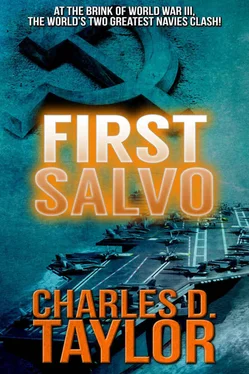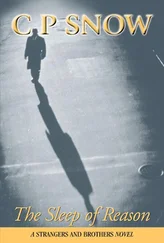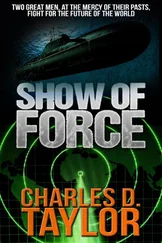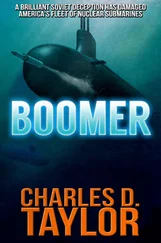The pilot looked at Cobb out of the corner of his eye. “Notice that?”
Cobb nodded, saying nothing. He put on the extra set of headphones to listen to the air-control net. There was dead silence for a moment. Then he heard the voices, normal at first, then more anxious, calling on the net. First they asked for radio checks, then requested those who answered to call the long-range planes on other frequencies.
But Cobb knew what the response would already be. Nothing. It was not a large burst as megatons went — probably no more than one or two, but at that height — two hundred kilometers, the computers projected — the damage would already be taking effect. The Air Force F-15s hadn’t gotten to it in time.
There would be no burst effect, nothing that would bring the launching of ICBMs in retaliation. There would be no loss of equipment or lives, nor even wounded or radiation victims. Instead, the victims would be the heart of the American offensive and defensive machine — electronics. The atmospheric ionization caused by the detonation of an atomic weapon at that height, well above the atmosphere, would halt all medium- and long-range communications for ranges of possibly 1,500 miles for up to two hours. Line-of-sight radio communications would not be affected, but satellites were out of the question, as were all air-defense and airborne communications. The electromagnetic pulse (EMP) could also damage solid-state electronics. Virtually all susceptible computers and sensors would be inoperative and even radar and microwave transmissions might be mute for as long as an hour.
It was long enough, Cobb knew, long enough to get in that first launch against Saratoga ’s battle group. The computers could only assume so much, but to his knowledge, no programs had ever been developed coordinating EMP with the Soviet Backfires launching their cruise missiles. Would they launch just before or just after the blast? How might the missiles be affected. Was it all timed so that Soviet submarines would pop to the surface and take control of the missiles, guiding them the last short distance to target?
Cobb didn’t know. Neither did Turner, nor Pratt. No one really did. And the computers were inoperative.
“What happened?” the pilot asked Cobb.
“Perhaps you’ll be able to tell your grandchildren that you saw the first atomic blast of the war — and survived it.”
The man blanched.
“Doesn’t affect you or me or anyone in the whole group. Not directly, anyway. But you can’t believe how screwed up the nervous system of this whole damn battle group is now.” He thought of what would follow. “Come on. Call up control and let’s get out of here. Pretty soon there will be something that’ll hurt you pretty bad.” It didn’t require a genius to do the simple mathematics necessary. Air-launched cruise missiles would be arriving in half an hour or so, give or take a few minutes. The Hawkeyes would do what they could, but they were a long distance from the carrier, they couldn’t communicate, and they couldn’t use the satellites in the way they were intended to, and the group’s own early-warning system was useless at this stage.
The pilot requested permission to take off. It was Admiral Turner’s voice that granted it. And then he added, “We’ll do what we can to hold ’em off, Cobb. Give Pratt my regards.”
Cobb learned much later how well they did.
The effects of the atomic blast had not been as severe as expected. Saratoga ’s Hawkeyes had done their job. They intercepted the Backfires before launching. An acceptable number of Soviet aircraft had gone down.
But there were fighters joining up with the Russian bombers, and the Hawkeyes took a beating after that. The assumption the Soviet submarines might take over control of the cruise missiles on their final run was correct. When they surfaced to do so, Turner’s helos and antisubmarine ships went after them. That accounted for the accuracy of another batch of missiles. But a number continued toward their target.
The ships undertook countermeasures, using everything they could to decoy the incoming missiles. That accounted for another batch. Sea Sparrow missiles accurately brought down more. But there were more than a dozen that survived all phases of the battle group’s defense.
Saratoga was actually the first ship to be hit. A missile impacted aft of the island on the starboard side, just below the elevator. Fires ignited on the hangar deck. A second missile hit just below the angled flight deck on the port side. A large section of deck ruptured. More fires erupted. The third missile penetrated the hull plating, detonating in the after engine room. The watch there died almost instantly, either from the blast or from escaping high-pressure steam. Saratoga was now operating on three shafts.
As the carrier was fighting her own battle, other ships in the group also came under fire. The frigate Gallery disappeared in a belch of flame as a missile exploded in her torpedo storage. A surviving captain of one of the nearby ships reported that within sixty seconds almost nothing remained of the little ship.
The stern of Deyo disappeared to the waterline.
The bridge of Macdonough was cleared by a direct hit. When her executive officer took command, he was told that the blast took out the bridge, the combat information center, and three decks below, and that the fires were out of control. Three minutes later the torpedoes in the ASROC launcher blew, and he watched the forward third of the ship drift away.
According to the computers, the first Soviet launch had been more effective than projected — perhaps even by them. It had never been considered that they would take advantage of the effect of a high-altitude nuclear blast. The computers also said that an aircraft carrier should be able to survive at least four cruise missile hits. Saratoga was trying to survive three. Fires in her hangar threatened fuel and ammunition. The angled deck was useless, as was the elevator that had been hit. There was no chance of getting the after engine room back on line. She could likely float after more than three direct hits, but was it worthwhile?
On the bridge, Admiral Turner explained to Saratoga ’s commanding officer that Soviet doctrine called for a second, equally devastating launch.
The initial assault on Saratoga and her battle group was taking place even as the commanding officers of Pratt’s battle group were meeting aboard Yorktown about four hundred miles to the west to make final plans for their defense. The radical nature of the attack — the creation of an electromagnetic pulse — had not been expected by most of those men. Only Carleton and Nelson were unsurprised; one of Pratt’s original projections had been based on the Soviet fleet attacking before ground forces moved into Germany. It was based on the persisting Russian concept that NATO forces in the North Atlantic and Mediterranean would have to be neutralized. If they were not, then NATO ground forces in Europe could be reinforced, control of the air could not be guaranteed, and a prolonged ground war would likely mean acceleration to the nuclear level.
The Russian hierarchy would accept nuclear war only if it was to combat a last-ditch NATO nuclear effort. Once the Russians thought the flow of battle in Europe was to their advantage, they would call for peace talks as their divisions swept across Central Europe to the Atlantic coast. By the time a cease-fire would actually be effected, NATO would no longer be a threat.
“They’re ahead of schedule,” Nelson whispered to Carleton. “Probably want their General Keradin — dead or alive. But I never expected they’d go for the nuclear stuff this early.”
Читать дальше












